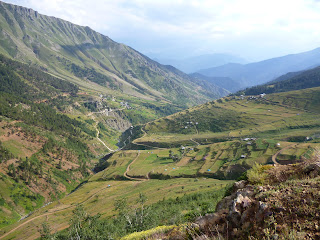My watch alarm has been set to 6:30am since arriving in Georgia.
It seems to be our sweet spot for decent rest, cool morning riding and long
days on the bike. Our goal every evening is to camp near water so we can clean
the road off at the end of one day, and fill our coffee pot at the beginning of
the next. With little exception we rise with the sun and soak up lazy cups
of silty Turkish jo and oatmeal with the assistance of Chris's handy Primus
camp stove. Our campsites are mostly in the middle of nowhere, but we ask
permission when we end near private property and have yet to be turned down.
This has landed us lakeside, tucked on the lee side of 12 foot hay mounds, at
the base of glaciers in the middle of forested paradise, and smack in the
middle of cow pasture. Our tent is a single poled, floor-less shelter that most
closely resembles a circus tent. It fits three people and gear, or four in a
pinch.
After breaking
down our florescent tee-pee, we load the bikes, consult one of our
numerous maps (paper and electronic) to get a sense of distance and elevation,
and hit the road. We have made a point of staying off the main roads- it
generally makes for less monotonous riding, we end up steeping
ourselves in the unexpected (dead ends, massively rutted roads, etc.), and it's
just plain fun to make it up as we go. We do well enough by asking locals about
route advice, particularly when none of our maps agree. Communication
boils down to a game of charades. We use "sign language" and very
limited Georgian and Russian to get everything from directions and simple
information about food and water, to highly advanced requests for super glue,
bolts and flashlights. The gesticulation that comes along with this does not
fail to entertain. Our biggest challenge is convincing people we want to ride
the "bad" road rather than asphalt. This is also entertaining because
95% of the country's roads fall into that "bad" category and we have
enjoyed a small majority of them.
Our afternoons are
never the same. We snack, we rest in the shade when needed, we suffer through
rough road a lot, but we have also adopted a "yes" policy that makes
each day unique. By never saying no to anything that is offered to us, we have
spent a lot of our time sharing drinks, food, and swimming holes; we have
enjoyed tours of aquaculture plots and hotels, accepted overnight stays at
cement factories and glitzy wedding halls, and entertained lots and lots
of awkward chats. We are definitely not just moving from A to B, but rather
bouncing along with the unintended and unanticipated.
Over the past 23
days we have managed to cover the Svaneti region, Kasbegi and the Military
Highway, and the Borjomi-Samtskhe region. We're in the geyser-laden land of
Borjomi proper now, and headed into the national park for a three day trek. Our
last days will be spent in the Kakheti region, where Georgians claim wine was
born. Cheney is our wine guru in motion and on his way to intern in Burgundy in
just a week or so. Chris and I will have the benefit of enjoying the area
through his expertise. So we'll wrap up with wine and castles and then move in
three very different directions. More on those plans and pictures very soon...


